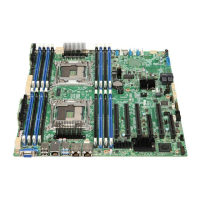Intel® Server Board S2600CW Family TPS Design and Environmental Specifications
Revision 2.4
11. Design and Environmental Specifications
11.1 Intel
®
Server Board S2600CW Design Specifications
The following table defines the Intel
®
Server Board S2600CW operating and non-operating
environmental limits. Operation of the Intel
®
Server Board S2600CW at conditions beyond
those shown in the following table may cause permanent damage to the system. Exposure to
absolute maximum rating conditions for extended periods may affect system reliability.
Table 88.Server Board Design Specifications
Operating Temperature
Board: 0°C to +55°C
System: +10°C to +35°C
Non-Operating Temperature -40°C to +70°C
Non-Operating Humidity 50% to 90%, non-condensing with a maximum wet bulb of
28°C (at temperatures from 25°C to 35°C)
Acoustic noise Sound power: 7.0BA with hard disk drive stress only at
room ambient temperature (23 +/-2C)
Shock, operating Half sine, 2g peak, 11 mSec
Shock, unpackaged System: Trapezoidal, 25g, velocity change 205
inches/second (80 lbs to < 100 lbs)
Vibration, unpackaged 5 Hz to 500 Hz, 2.20 g RMS random
Shock and vibration, packaged
ISTA (International Safe Transit Association) Test
Procedure 3A
Note:
1. Chassis design must provide proper airflow to avoid exceeding the processor maximum case temperature.
Disclaimer Note: Intel ensures the unpackaged server board and system meet the shock
requirement mentioned above through its own chassis development and system configuration.
It is the responsibility of the system integrator to determine the proper shock level of the board
and system if the system integrator chooses different system configuration or different chassis.
Intel Corporation cannot be held responsible if components fail or the server board does not
operate correctly when used outside any of its published operating or non-operating limits.
Disclaimer Note: Intel Corporation server boards contain a number of high-density VLSI and
power delivery components that need adequate airflow to cool. Intel ensures through its own
chassis development and testing that when Intel server building blocks are used together, the
fully integrated system will meet the intended thermal requirements of these components. It is
the responsibility of the system integrator who chooses not to use Intel developed server
building blocks to consult vendor datasheets and operating parameters to determine the

